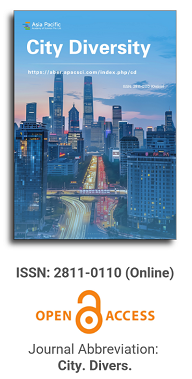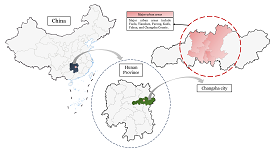
Asia Pacific Academy of Science Pte. Ltd. (APACSCI) specializes in international journal publishing. APACSCI adopts the open access publishing model and provides an important communication bridge for academic groups whose interest fields include engineering, technology, medicine, computer, mathematics, agriculture and forestry, and environment.

As China's pillar industry, the property market has suffered a considerable impact in recent years, with a decline in turnover and many developers at risk of bankruptcy. As one of the most concerned factors for stakeholders, housing prices need to be predicted more objectively and accurately to minimize decision-making errors by developers and consumers. Many prediction models in recent years have been unfriendly to consumers due to technical difficulties, high data demand, and varying factors affecting house prices in different regions. A uniform model across the country cannot capture local differences accurately, so this study compares and analyses the fitting effects of multiple machine learning models using February 2024 new building data in Changsha as an example, aiming to provide consumers with a simple and practical reference for prediction methods. The modeling exploration applies several regression techniques based on machine learning algorithms, such as Stepwise regression, Robust regression, Lasso regression, Ridge regression, Ordinary Least Squares (OLS) regression, Extreme Gradient Boosted regression (XGBoost), and Random Forest (RF) regression. These algorithms are used to construct forecasting models, and the best-performing model is selected by conducting a comparative analysis of the forecasting errors obtained between these models. The research found that machine learning is a practical approach to property price prediction, with least squares regression and Lasso regression providing relatively more convincing results.
Issue release: 30 June 2025
This study investigates the impact of high-speed rail (HSR) on athlete mobility, sport event management, and regional economic development, particularly in the context of major international sporting events. The research aims to address the role of HSR in improving accessibility, reducing travel times, and supporting efficient logistics for athletes, event staff, and spectators. This study employs a systematic literature review (SLR) methodology, using data from Scopus, to synthesize existing research. The review process involved screening 962 documents, resulting in the analysis of 71 relevant articles. The study follows PRISMA and SPAR-4-SLR guidelines to ensure methodological rigor and transparency in selecting and analyzing studies. The study highlights both the positive contributions of HSR, including enhanced mobility and economic benefits for host cities, as well as the challenges posed by spatial imbalances in infrastructure development. While HSR facilitates improved connectivity and contributes to the economic growth of metropolitan areas, smaller cities and peripheral regions often face marginalization in terms of economic opportunities and event participation. The findings suggest that although HSR significantly enhances event logistics, there is a pressing need for more inclusive infrastructure planning to ensure equitable access to these benefits. Additionally, the study underscores the environmental sustainability of HSR systems as an alternative to more carbon-intensive transport modes. Overall, this research provides insights into how HSR can be leveraged to improve the management of international sporting events and contribute to long-term urban and regional development while also addressing the existing disparities in accessibility and economic development across regions.
Issue release: 30 June 2025
The study of industrial areas damaged by the war in 2022–2024 in more than twenty Ukrainian cities and their adaptation to other functions is extremely relevant in our time. The purpose of the article is to reveal the basic principles of the revitalization of industrial and residential areas of the Ukrainian cities of Volnovakha, Rubizhne, Severodonetsk, Lysychansk, Popasna, Shchastia, Toretsk, Bakhmut, Soledar, Avdiivka, Maryinka, Krasnohirka, Vugledar, Mariupol, Donetsk region, Orikhiv (Zaporizhzhya region), Kharkiv, Kupyansk, Bakaliya, Izyum (Kharkiv region), Kherson, Irpin, Bucha (Kyiv region), which were destroyed or damaged by a full-scale war, ensuring environmental sustainability and economic efficiency, taking into account socio-cultural aspects. The article explores the core principles of industrial site revitalization and provides successful examples of their implementation. The transformation of abandoned areas and the redistribution of their functions are analyzed. The article’s methodology is based on general scientific methods, including literature analysis, case comparisons, and synthesis of collected data to develop a professional approach to revitalizing neglected industrial sites. The research incorporates an analysis of international analogs of industrial site revitalization, as well as practical visits and field inspections of abandoned industrial areas in Ukraine, which help identify the primary methods and principles applied in revitalization projects. The study emphasizes the importance of revitalization as a key tool for transforming spaces into functional and aesthetically appealing architectural objects. Based on an analysis of international experience in revitalization, recommendations are developed for effective planning and implementation of revitalization projects for neglected industrial areas in Ukrainian cities. The findings provide a theoretical foundation for understanding the revitalization of abandoned urban spaces, promoting sustainable urban development, improving urban functionality, and offering practical applications.
Issue release: 30 June 2025
As urban space available for new construction continues to diminish, urban renewal strategies have increasingly shifted toward micro-renewal approaches. Within this framework, public art serves as a vital medium for urban cultural development and has been effectively integrated into community spaces under the paradigm of human-centered urban micro-renewal. This study systematically explores the forms, principles, and mechanisms of community public art. First, it establishes the synergistic relationship between urban micro-renewal and community public art. It then identifies six distinct artistic forms: spatial transformation, sculptural installations, murals and wall paintings, public facilities, digital media, and artistic events. Building upon this classification, the study delineates four core principles that community public art should adhere to: the participatory principle of human-centered engagement, the principle of locality emphasizing cultural distinctiveness, the principle of gradual progression ensuring sustainable development, and the social principle of art education. Through comparative case analysis, the study reveals the multidimensional role of community public art in restructuring power dynamics, driving community transformation, and reshaping cultural identity. The findings demonstrate that community public art not only enhances the spatial environment and improves community quality but also fosters social integration and strengthens cultural identity, providing an innovative pathway for urban governance. Finally, the study acknowledges its limitations and outlines future research directions, aiming to contribute to both theoretical discourse and practical applications in community public art.
Issue release: 30 June 2025
The paper delves into the role and power of places of memory in preserving and strengthening the collective memory and identity of Greeks who originated from Asia Minor and specifically Smyrna. Historical data are presented regarding the persecution of this community and the triptych “place-collective identity-collective memory” is thoroughly studied. Through semi-structured interviews, and participatory design methods, with the collaboration of users, landscape architect, agronomist, and sociologist, the landscape design proposal aims to create the First Nationwide Open-Air Museum of Smyrna in Thessaloniki, Greece. The new land uses are based on the shaping and preservation of the collective memory and identity of Smyrnaeans, and the coexistence of historical and cultural elements in a modern design canvas. Users and visitors perceive the landscape as a document of the Smyrnaean culture, which narrates the history of their community, allowing them to define their particular identity and identify themselves as “us”.
Issue release: 30 June 2025
The growing importance of urban spaces that facilitate socio-cultural exchange and artistic expression generates a series of current debates on inclusion within urban arts since there is not more emphasis on considering accessibility and the active participation of people and artists with disabilities as fundamental aspects. The main goal is to contribute to the comprehensive development of the theory of analytical thinking through the artistic representation of public space to validate accessibility and functional diversity, which affect inclusive design and promote active participation in urban art. The development of arguments is classified into ⅰ) the evolution of urban art and its relationship with functional diversity; ⅱ) participation of (artists and) people with disabilities in urban art; and ⅲ) urban art as an inclusive and transformative platform. This section discusses the argumentative structure in creative production that urban art is a space for social interaction and the construction of collective identity through art representation and inclusion. It is to deepen this theory of analytical thinking to contribute to the development of artworks in inclusive and accessible public spaces, depending on urban infrastructures. Urban art must have a space where all identities and collectives that are concerned about the restriction towards a more diverse and equitable urban culture for the whole society, independent of people with disabilities in public space, are recognized by the artistic work, challenging ideas about the meaning of being an artist with functional diversity.
Issue release: 30 June 2025
This review provides a comprehensive analysis and develops an integrated framework for incorporating Fengshui principles into modern architectural design, focusing on their multidimensional impact on occupant well-being. In ancient China, Fengshui is a sophisticated practice integrating spatial layout and environmental optimization, drawing from natural sciences such as geography, geology, meteorology, and environmental studies. Its core objective is to harmonize the natural and built environments, creating optimal living conditions that support a harmonious coexistence between humans and nature. By regulating the flow of spatial energy, Fengshui fosters livable and balanced spaces, enhancing thermal comfort, aesthetic appeal, cultural and spiritual significance, and environmental sustainability. These benefits underscore Fengshui’s contemporary relevance in modern architectural practices, showcasing its unique potential to create spaces that promote holistic well-being. This study systematically identifies four key advantages of Fengshui and explores its reintegration into modern design, emphasizing its historical wisdom in respecting and harmonizing with nature. Despite facing obstacles related to scientific validation and cultural adaptability, Fengshui is proposed as a significant theoretical framework and practical resource for architects and urban planners. It can be utilized to design environments that promote human well-being, enrich cultural significance, and support sustainability.

Prof. Mehmet Cetin
Kastamonu University,
Turkey
Polish Scientific Bibliography


 Open Access
Open Access